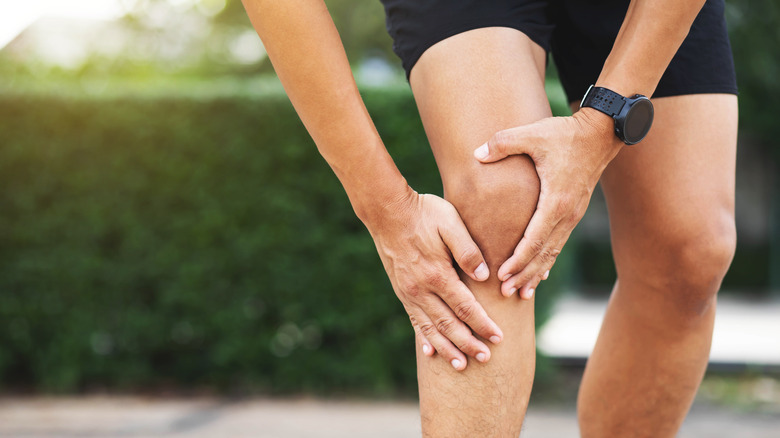Tips For Getting Back Into Exercise After Experiencing A Gout Flare
If you live with gout, you'll know firsthand how difficult the condition can be. The pain and swelling in your joints can make it challenging to move around, and simple tasks like walking or standing can become painful and uncomfortable. This can limit your ability to perform daily activities, especially exercise.
Gout occurs when too many uric acid crystals are in the joints. Uric acid is a waste product produced when purines are broken down by the body. Purines are naturally found in the body as well as in various foods and drinks, says the University of Rochester. Normally, the body can eliminate uric acid through the kidneys and urine. However, when too much uric acid is present, it can accumulate in the blood, forming crystals in the joints. These uric acid crystals can cause sudden, severe pain and swelling in the affected joints, known as a gout flare. The most commonly affected area is the big toe, but gout can affect other joints, including the ankles, knees, elbows, and wrists.
Regular exercise can be an important part of managing gout and reducing the frequency and severity of gout flares. However, if you've recently had a gout flare, certain exercises are better than others to prevent symptoms from worsening.
How to exercise after a gout flare
If you have experienced a gout flare-up, the first step in getting back into exercise is to consult your doctor. They can advise you on what exercises are safe and how to gradually increase your activity level. As a guide, it's always best to take things slowly. Even if you were very active before the flare-up, limiting exercises that put pressure on the joints is still important, as Healthline explains. This way, you avoid aggravating your symptoms.
Avoid high-intensity exercise, particularly during and immediately after a gout flare-up, as this can raise uric acid levels in the body. High-intensity exercises involve short bursts of intense effort followed by periods of rest or low-intensity exercise, per Harvard Health Publishing. It's best to engage in low-impact activities during a gout flare-up and to gradually increase the intensity of exercise over time.
Low-impact exercises like swimming and walking are a great way to stay healthy without putting too much stress on your joints, says Healthline. Stretching exercises like yoga may also help reduce stiffness and improve mobility, which can help you get back into exercise more quickly. Finally, staying hydrated when exercising is important, especially if you have gout. Drinking plenty of water can help prevent dehydration, which is associated with excess uric acid in your system.
Why exercise is important for people with gout
Exercise is important for people with gout due to its inflammation-reducing potential. Inflammation is a common gout symptom and can cause pain and swelling in the affected joints. In a 2017 study published in the journal Brain, Behavior, and Immunity, exercise was shown to reduce inflammation in the body by promoting the production of anti-inflammatory cytokines and reducing the production of pro-inflammatory cytokines. A 2020 study published in the journal PLoS One found that regular exercise was associated with lower levels of C-reactive protein (CRP), a marker of inflammation, in people with gout. However, high-intensity exercise has been associated with increased inflammation, per a 2020 review published in the journal Frontiers in Physiology.
Gout is also associated with high uric acid levels, which may be a risk factor for cardiovascular disease, according to a 2021 article published in the journal Hypertension. Although high-intensity exercises may also increase uric acid levels, moderate exercise may help reduce them, per Ergotec Health. In addition to reducing inflammation, moderate exercise can positively impact overall health and well-being. Exercise like yoga may help reduce joint pain, as found in a 2022 systematic review and meta-analysis published in the journal RMD Open. Generally speaking, regular exercise can reduce the risk of chronic diseases such as heart disease, diabetes, and obesity, all of which are risk factors for gout and can contribute to gout flares.



